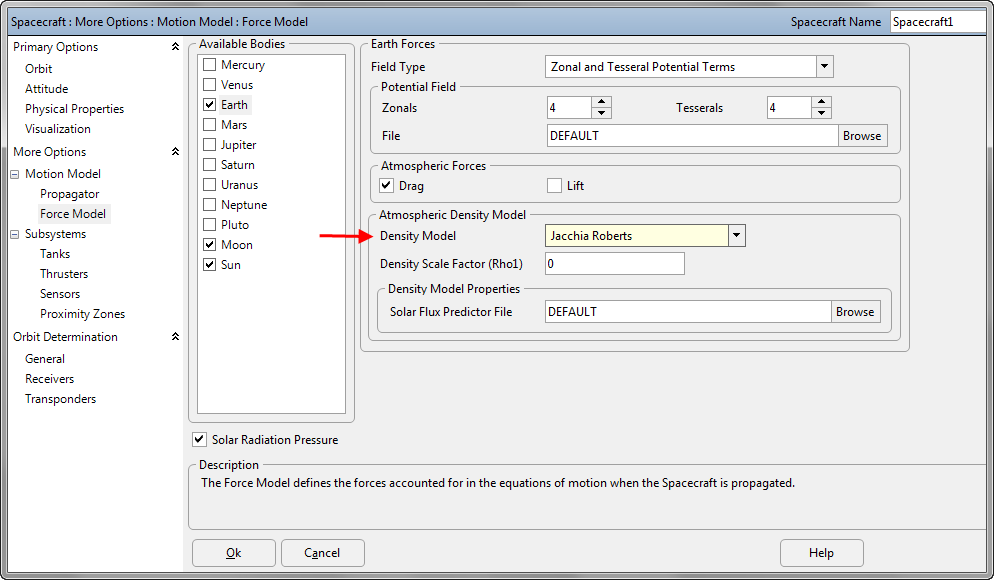The Jacchia-Roberts atmospheric density model uses monthly mean smoothed values of solar radiation along with dimensionless geomagnetic index (Kp) to produce atmospheric density values. An input file is used to provide definitive and/or predicted values for exospheric temperature and geomagnetic index. FreeFlyer uses Jacchia Roberts 1972 for atmospheric density modeling.
By default, FreeFlyer will use the Celestrak Space Weather file included in the installation, but you can specify a different file (such as a Schatten Solar Flux file) or even specify your own custom drag model using a User-Created Atmospheric Drag File. This is useful for performing analysis using different predicted magnitudes and phases of the solar cycle.
It is important to note that the Celestrak Space Weather file is limited to a certain date range, and contains both observed and predicted data. For simulations before the first date in the file, FreeFlyer will use the first data entry in the file. For simulations after the last date in the file, FreeFlyer will use the last data entry in the file. This means that, outside the range of the file, the density will not be affected by large solar cycle variations; however, seasonal effects resulting from the changing position of the Sun with respect to the Earth over the course of a year will still be modeled.
This page is divided into the following sections:
References:
1."Revised Static Models of the Thermosphere and Exosphere with Empirical Temperature Profiles," Jacchia, L. G., Smithsonian Astrophysical Observatory Special Report No. 332 (1971) 2."An Analytical Model for Upper Atmosphere Densities Based Upon Jacchia's 1970 Models, Celestial Mechanics," Roberts, E. R. Jr., Volume 4, Issue 3-4, 368-377 (1971) 3."Goddard Trajectory Determination System (GTDS) Mathematical Theory", FDD/552-89/001 and CSC/TR-89/6001, July 1989 |
Enabling Jacchia-Roberts Drag Modeling
The default atmospheric density model used for modeling the Earth's atmosphere is the Analytic Density Model. To enable the Jacchia-Roberts Density Model for a Spacecraft, edit the Spacecraft, proceed to the Force Model page, and select Earth from the list of celestial bodies as shown in the image below.
Then ensure that "Jacchia Roberts" is selected in the Density Model drop-down menu.

To enable Jacchia-Roberts atmospheric density modeling via FreeFlyer script, use the following syntax:
Alias fm = (Spacecraft1.Propagator AsType RK89).ForceModel; // This alias is used to shorten the script examples below
fm.AtmosphericDensityModel = 3; |
Where the AtmosphericDensityModel can be one of the following:
•1 for Analytic density •2 for Harris-Priester density model •3 for Jacchia-Roberts density model •4 for MSIS-2000 •5 for MSIS-90 •6 for MSIS-86 |
You can access the associated Jacchia-Roberts drag model properties via the ForceModel object, using the following syntax:
Report fm.Kp; // Report Geomagnetic Index (Kp) value Report fm.Ap; // Report Planetary Index (Ap) value Report fm.Tc; // Report Exospheric Temperature in Kelvin Report fm.F107Index; // Report current F10.7 index Report fm.F107IndexAverage; // Report 81-day average F10.7 index value |
Note: You can find additional information about these properties on their object pages: ForceModel.Kp, ForceModel.Ap, ForceModel.Tc, ForceModel.F107Index, and ForceModel.F107IndexAverage.
Setting the Solar Flux Predictor File
By default, FreeFlyer uses the "space_weather_celestrak.csv" data file for Jacchia-Roberts atmospheric modeling, but you can specify a different file using the "Solar Flux Predictor File" file browser shown in the image above or via FreeFlyer script using this syntax:
fm.SolarFluxFilename = "JRdragfile.dat"; |
Where "JRdragfile.dat" specifies the path and filename of the custom Jacchia-Roberts drag file.
For example, when working with Schatten Solar Flux files, you can specify the desired Schatten file in the file browser or specify it via FreeForm:
fm.SolarFluxFilename = "Meannom.dat"; |
See Also
•ForceModel Properties and Methods
•Solar System settings that affect Spacecraft Propagation
•User-Created Atmospheric Drag Files